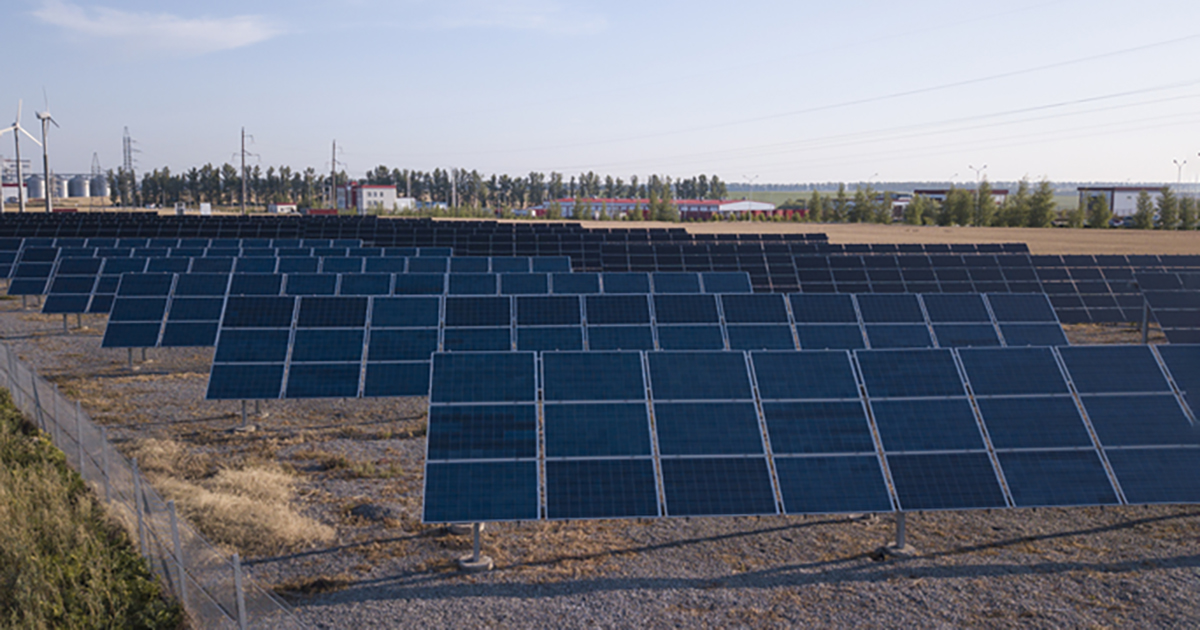Tapping into the power of the sun offers commercial and industrial facilities more control over their utility bills and the ability to operate in a more sustainable fashion. Plummeting prices and improved technology make a host of options available for companies that want to go solar. But they’re left with a lot of information to parse and deliberations to make. We have created this three-part commercial and industrial solar series to shed light on the types of solar installations possible today, important technology considerations, and system financing and cost options available to companies of all sizes. See Part I: Everything Under the Sun here.
Part 2
Questions for Companies Considering Solar Power
As we covered in Part I of our solar series, technology advancement and plummeting prices make solar power a very attractive consideration for businesses of all sizes.
In Part II we are going to answer some important questions for companies considering solar power, and some helpful context as to how these decisions could impact your business.
In Part II we are going to answer some important questions for companies considering solar power, and some helpful context as to how these decisions could impact your business.
Should I Consider Buying, Leasing or Other Arrangements to go Solar?
Along with the many different types of solar technology, there are different ways that a company can invest (or not!) in solar energy.
Buying Solar
Whether buying photovoltaic panels for electricity or solar thermal collectors, owning your own solar system is the surest way to maximize the value if you are able to take on the upfront cost.
Solar systems for commercial and industrial properties can cost tens of thousands of dollars depending on the desired size and capabilities.
The size of the system, technology used, and related components would be determined based on the on-site power consumption needs, available solar resources (called ‘insolation’), and opportunities to generate additional revenue through markets or incentives. If a company owns their system, there will also be maintenance and operational costs over the years to ensure peak performance.
Typical return on investment (ROI) for solar installations can be anywhere for 5-10 years. With good solar exposure, suitable system siting, and utility rate structures that encourage solar and self-consumption, purchased solar equipment can go from depreciable asset to savings and revenue generation in a few short years.
Leasing Solar
Not every business is well suited for owning solar panels, or may not want to take on the upfront investment for a solar system.
Many companies today offer no-upfront cost solar installation – almost exclusively for photovoltaic systems. Leased systems may also include advanced controls and energy storage for backup power for additional capabilities. While leased solar panels typically do not require upfront investment, they will most likely involve a contract with multiple provisions to consider.
In lease agreements, lessees purchase the solar energy generated by the system from a third-party provider who owns, operates, and maintains the system, alleviating those burdens. This is called a power purchase agreement (PPA), and the energy is almost always sold at a rate cheaper than available utility power, creating immediate monthly savings. PPA contracts typically run a number of years, and there are often penalties for early termination and system removal.
The system owner gets the guaranteed revenue stream from selling you the electricity, and also gets to keep any renewable energy credits (RECs) generated by the system, which have value in different jurisdictions with clean energy requirements. This is an important distinction – companies leasing solar systems are not generating RECs for themselves, and cannot claim the carbon credit any RECs would offer.
Hybrid Offerings & Community Solar
Not all solar projects fit neatly into the buy or lease dichotomy, and sometimes companies can explore hybrid approaches or different types of off-site solar power as well.
Less typical but increasingly common are hybrid ownership systems, where different stakeholders own different parts of the solar system and its output. For example, a warehouse with a lot of great roof space for solar panels, but little on-site energy load to consume the output, may find it beneficial to partner with a solar company who can better manage the excess in competitive markets. Some projects can also be joint endeavors between a building owner, their utility, and a third-party service provider, where each has a stake in system capabilities.
When it comes to off-site solar solutions, there are a few options. Bigger companies can simply afford to build their own wind or solar farms off-site, and operate renewable energy systems themselves, like Google and Apple. For smaller companies, there is also the option of community solar, where one company builds a solar farm and then sells ‘shares’ of the solar output to a number of companies and individuals.
As the technology and economic landscape continues to evolve, it is certain that new creative business and ownership models will be introduced in the future to meet the needs of more and more customers.
Buying Solar
Whether buying photovoltaic panels for electricity or solar thermal collectors, owning your own solar system is the surest way to maximize the value if you are able to take on the upfront cost.
Solar systems for commercial and industrial properties can cost tens of thousands of dollars depending on the desired size and capabilities.
The size of the system, technology used, and related components would be determined based on the on-site power consumption needs, available solar resources (called ‘insolation’), and opportunities to generate additional revenue through markets or incentives. If a company owns their system, there will also be maintenance and operational costs over the years to ensure peak performance.
Typical return on investment (ROI) for solar installations can be anywhere for 5-10 years. With good solar exposure, suitable system siting, and utility rate structures that encourage solar and self-consumption, purchased solar equipment can go from depreciable asset to savings and revenue generation in a few short years.
Leasing Solar
Not every business is well suited for owning solar panels, or may not want to take on the upfront investment for a solar system.
Many companies today offer no-upfront cost solar installation – almost exclusively for photovoltaic systems. Leased systems may also include advanced controls and energy storage for backup power for additional capabilities. While leased solar panels typically do not require upfront investment, they will most likely involve a contract with multiple provisions to consider.
In lease agreements, lessees purchase the solar energy generated by the system from a third-party provider who owns, operates, and maintains the system, alleviating those burdens. This is called a power purchase agreement (PPA), and the energy is almost always sold at a rate cheaper than available utility power, creating immediate monthly savings. PPA contracts typically run a number of years, and there are often penalties for early termination and system removal.
The system owner gets the guaranteed revenue stream from selling you the electricity, and also gets to keep any renewable energy credits (RECs) generated by the system, which have value in different jurisdictions with clean energy requirements. This is an important distinction – companies leasing solar systems are not generating RECs for themselves, and cannot claim the carbon credit any RECs would offer.
Hybrid Offerings & Community Solar
Not all solar projects fit neatly into the buy or lease dichotomy, and sometimes companies can explore hybrid approaches or different types of off-site solar power as well.
Less typical but increasingly common are hybrid ownership systems, where different stakeholders own different parts of the solar system and its output. For example, a warehouse with a lot of great roof space for solar panels, but little on-site energy load to consume the output, may find it beneficial to partner with a solar company who can better manage the excess in competitive markets. Some projects can also be joint endeavors between a building owner, their utility, and a third-party service provider, where each has a stake in system capabilities.
When it comes to off-site solar solutions, there are a few options. Bigger companies can simply afford to build their own wind or solar farms off-site, and operate renewable energy systems themselves, like Google and Apple. For smaller companies, there is also the option of community solar, where one company builds a solar farm and then sells ‘shares’ of the solar output to a number of companies and individuals.
As the technology and economic landscape continues to evolve, it is certain that new creative business and ownership models will be introduced in the future to meet the needs of more and more customers.
What are Some Technology and System Components I Should Consider?
The modern solar system is more than just panels producing electricity whenever the sun comes up. Advanced controls and a plethora of components can augment system capabilities to address any energy needs a company may have.
It’s Electric?
In the first part of our series, we described both solar electric (photovoltaic) and solar thermal energy systems. Companies with high thermal energy loads — hotels and resorts, swimming pools, food manufacturing — will want to consider solar thermal as a way to meet those needs. Most other companies will be seeking photovoltaic systems to meet their electrical needs, which can also include less intense thermal needs like HVAC or electric cooking.
Power Quality
Companies considering solar systems where the energy will be consumed onsite will also need to take into account potential power quality concerns. Not every electron is created equal, and consistent phase, frequency, and voltage are critical for advanced manufacturing facilities, data centers, and other high-tech operations. There are a number of solutions available to ensure power quality.
Resilience & Reliability
Along with reducing dependence on the grid and cleaning up their power supply, the next big ask from companies looking at solar power is reliability and resilience. The cost of blackouts, even momentary, can be tens of thousands of dollars. Extended power outages can cripple operations and lead to loss of product and inventory.
So what happens when the grid goes down? Even if it is installed on your roof, unless additional technology is deployed, all solar systems are ‘grid-tied’, meaning they feed directly into the broader electric grid. In essence you do not consume the solar from your roof, you export it to the grid thereby reducing your load and electric bill, unless you have energy storage or advanced controls on site.
Adding batteries to a solar system can provide reliable power when the grid goes down for anywhere from a few hours to indefinitely, depending on the size of the system. Backup batteries – typically lithium ion, lead acid, or sodium-based – will add to the overall system cost (or lease payment), the additional reliability could be priceless.
There are many other questions that companies should ask when they are looking into solar solutions, and we are here to help you navigate those options.
It’s Electric?
In the first part of our series, we described both solar electric (photovoltaic) and solar thermal energy systems. Companies with high thermal energy loads — hotels and resorts, swimming pools, food manufacturing — will want to consider solar thermal as a way to meet those needs. Most other companies will be seeking photovoltaic systems to meet their electrical needs, which can also include less intense thermal needs like HVAC or electric cooking.
Power Quality
Companies considering solar systems where the energy will be consumed onsite will also need to take into account potential power quality concerns. Not every electron is created equal, and consistent phase, frequency, and voltage are critical for advanced manufacturing facilities, data centers, and other high-tech operations. There are a number of solutions available to ensure power quality.
Resilience & Reliability
Along with reducing dependence on the grid and cleaning up their power supply, the next big ask from companies looking at solar power is reliability and resilience. The cost of blackouts, even momentary, can be tens of thousands of dollars. Extended power outages can cripple operations and lead to loss of product and inventory.
So what happens when the grid goes down? Even if it is installed on your roof, unless additional technology is deployed, all solar systems are ‘grid-tied’, meaning they feed directly into the broader electric grid. In essence you do not consume the solar from your roof, you export it to the grid thereby reducing your load and electric bill, unless you have energy storage or advanced controls on site.
Adding batteries to a solar system can provide reliable power when the grid goes down for anywhere from a few hours to indefinitely, depending on the size of the system. Backup batteries – typically lithium ion, lead acid, or sodium-based – will add to the overall system cost (or lease payment), the additional reliability could be priceless.
There are many other questions that companies should ask when they are looking into solar solutions, and we are here to help you navigate those options.





